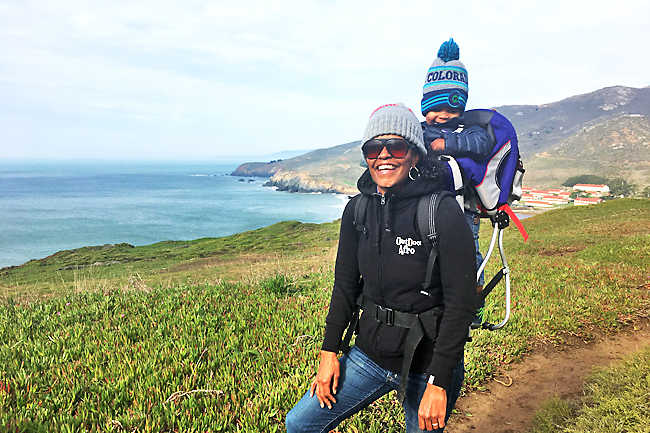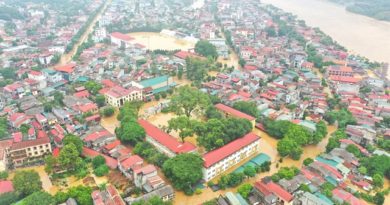FAMILY TOURISM: Tips and ideas for getting outdoors with a baby or toddler
Zoë Polk and son Quincy at Marin Headlands in the Golden Gate National Recreation Area in California
.
THREE weeks after Shanti Hodges’s son, Mason, was born, she felt both blissful and anxious, fearful she would develop postpartum depression and fretting over life in general. She had long found solace in the outdoors, so she asked women in her new-mother’s group whether they’d like to go on a half-mile trail walk at a park near her home in Portland, Oregon.
Hodges laughs at the memory of all the baby supplies she packed for that stroll back in 2013, where she was accompanied by a handful of other women with their babies. Subsequent walks and longer hikes drew more and more adults with babies and toddlers in tow.
“I knew I’d touched on something because of all the response I was getting,” said Hodges, who initially founded Hike it Baby as a newsletter and Facebook page. Within a year, the movement of families helping each other get outside and on the trails had spread well beyond the Portland area. Now Hike it Baby is a non-profit organisation with 650 volunteer branch ambassadors in all states and most major cities. It hosts about 2,500 outings a month.
“There’s a lot of information out there about how the outdoors is good for children, but it’s geared to school-age kids,” Hodges said. “But the positive impact can be felt much earlier. The younger they start, the better. Their minds and bodies will totally thrive.”
Of course, getting outdoors fosters wellness among adults, too, by strengthening their social networks and providing fresh air. While Hike it Baby is the largest group devoted to hiking with wee ones, other community-connecting groups – such as Adventure Mamas, Women Who Hike, Outdoor Afro and Latino Outdoors – can be great resources for family-friendly excursions.


.
To help encourage more adults to take their little ones outside, Hodges recently wrote Hike it Baby: 100 Awesome Adventures with Babies and Toddlers, which details hikes suitable for the younger set around the country along with tips for taking babies and toddlers into nature. Here are tips from Hodges and other parents and experts.
Start young: Zoë Polk took her son, Quincy, to the beach near her San Francisco home when he was eight days old. “I just wanted him to experience everything: the sounds, smells, the wind on his face,” said Polk, national programme director of Outdoor Afro, which connects African Americans to the outdoors. “I grew up in Newport News, Virginia, and the ocean was a big part of my life.” Since then, Quincy, now two-and-a-half, has accompanied her on dozens of hikes.
Minnesota residents and adventure bloggers Maura and Bobby Marko run the Facebook group Backpacking With Babies and Kids, and Maura is an ambassador for Hike it Baby. They took Jack, now four, on his first hike when he was two weeks old, and daughter Rowan, who is almost two, started even earlier.
As for toddlers, Tovah Klein, director of Barnard College Center for Toddler Development and author of How Toddlers Thrive, advises parents to take children that age outside every day. “So often, children are put in activities that tell them how to play. Outdoors, particularly in the woods, children aren’t being told what to do, so they can discover on their own,” said Klein, who started camping with her children before they were two. “For parents concerned with academic learning, it’s all there. Big and little, colours and textures, sensory feelings. Children also learn about their body in motion by being on different surfaces.”
Research trails beyond ratings: “Family-friendly” trail ratings aren’t always reliable, because they’re generally geared toward older children. That’s where community crowd-sourcing and guidebooks such as Hike it Baby come in handy. (Hike it Baby has teamed with LL Bean to publish an online directory of about 1,000 hikes, due out in January.) Considerations not found in typical guidebooks that parents should be aware of include cellphone reception, drinkable water, benches for nursing, restrooms, diaper-changing areas and a listing of “potential child or baby hazards” such as poison ivy, steep drop-offs and rushing water.
Buy an appropriate carrier: Hodges recommends researching options at the nonprofit Babywearing International, as well as trying on an assortment of carriers and getting advice from fellow hikers. Her book also includes tips for going tandem – carrying two children in carriers.
Be prepared to tend to business trailside: Polk, whose son is now two-and-a-half, said many parents ask her about trailside diaper changing. Her tips include having a cloth to place children on, checking for poison plants and rocks and shielding their faces from the sun.
As for nursing and bottle feeding, it’s “a really big issue,” Hodges said. She perfected the art of breastfeeding while in motion with her son in his carrier and has taught many moms do the same (it’s also detailed in her book). “It’s game changing for so many women and gives them incredible freedom,” Hodges said. Otherwise, parents can find spots to sit on, such as logs, to stop and nurse or bottle feed. For those packing breast milk or formula on a summer hike, Hodges’s book recommends starting out with a frozen bag and thawing it along the way.
Don’t limit yourself: In addition to hikes, Maura and Bobby Marko take their children on backpacking and canoe camping trips, which they chronicle on their blog, WeFoundAdventure.com. (Canoe camping involves traveling to your camping area via canoe rather than by driving or backpacking.)
The Markos first canoe camped in 2016, when Jack was two and Maura was six months pregnant with Rowan. Maura said she had been craving wilderness and thought a trip to the famed Boundary Waters Canoe Area Wilderness would be the solution. “We’d never been there or camped with canoes, but it’s a great way to get into the wilderness and be able to take more with you.” After a test run, they planned a full trip. Since then, the family has gone a few more times, and along the way have become de facto experts in canoe camping with kids.
“Everyone asks, ‘Don’t the kids want to jump out?’ but no. They both can sit in a canoe for such a long time,” Maura said. “That surprises parents. We let them lean over and splash in the water. Of course we totally focus on safety.” (One way they do that is by having their canoe towed over large lakes, both because big bodies of water have more movement and to save time and energy.)
In the summer of 2017, the Markos completed a three-leg, three-week journey through Boundary Waters, first by biking in, then paddling and then camping and doing day hikes. The original plan had included backpacking, but the trail ended up being way too rugged. “It wasn’t fun or safe, so we turned back around and went car camping instead,” Bobby said.
The couple, who speak frequently at outdoor events – including Canoecopia, the world’s largest paddle sports consumer event, held in Wisconsin every March – are seeing more interest in backpacking and canoe camping with young children.
“This past year at Canoecopia our presentation was standing room only, with about 100 people. Overall, we’re seeing many more families there,” Bobby said. “We always tell people, if you want that wilderness experience, canoe camping is the way to go. You can bring all your car-camping gear and you don’t have to buy specialised equipment, just rent a canoe and paddles. A lot of people find that aspect appealing.”
The couple is hearing from more and more parents wanting to get outside with their young children, they said.
“They want tools, and they also want to hear about our failures,” Maura said. “What we say is, ‘Failure isn’t turning around; failure is not trying.’ ” – Text and Photos by The Washington Post

All photographs, news, editorials, opinions, information, data, others have been taken from the Internet ..aseanews.net | [email protected] | For comments, Email to : Icarus d’ Greek | [email protected] | – Contributor









